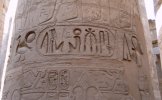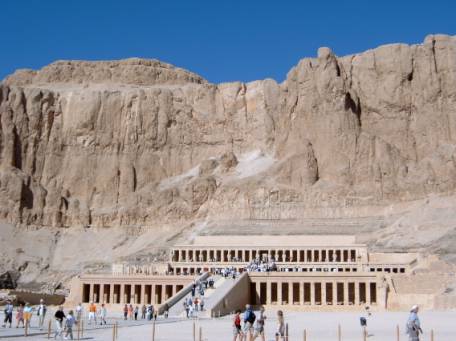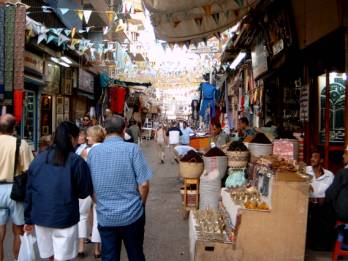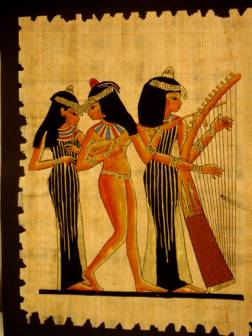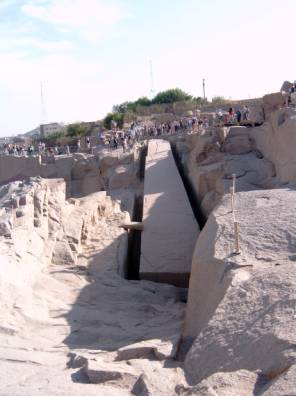14. November 2004 11:02
by Rene Pallesen
0 Comments
Bedstemor's 85th Birthday ( 13 - 20 Nov 2004 )
14. November 2004 11:02 by Rene Pallesen | 0 Comments
Bedstemor's 85th Birthday ( 13
- 20 Nov 2004 ) |
Ancient Egyptian stories and legends have long made their mark through movies such as "Cleopatra", "The Mummy" and wowed us women with Omar Sharif's performance in "Lawrence of Arabia" and "Doctor Zhivago" and more recently in cartoons such as "The Prince of Egypt". There is a certain mystic about middle east portrayed to us from a very young age when we hear bedtime tales like "Ali Baba the 40 Thieves" or "Sinbad the Sailor" - most of us have a dream of seeing the pyramids. I was very lucky to have the opportunity 20 years ago to come to Egypt with my parents and at 10 years old, there's only so much a child can remember. But this year, the Pallesen Family once again get together for the Matriach's 85th birthday. It is tradition for the family to come together and travel to an exotic country - in the past Tunisia, Morocco, Gambia and for Grandmother's last wish, to see the pyramids of Egypt, that her husband saw 45 years earlier. The Matriach's three children, six grandchildren (Nikolai could not make it), four greatgrandchildren and respective spouses all came together for a week in magical Egypt. It is autumn with warm days and cool nights - a contrast to the approaching winter in Denmark. |
Saturday 13 November 2004 Departure for Egypt Our family had to leave Falster at 2:30am to catch a 6:30 flight, 4½hr later we arrived at Cairo Airport. I have dim memories of a very warm airport in complete chaos, with people pushing to get their luggage through, shouting over a mad din. Instead we found a rather clean and uncrowded airport. We were met by the AB Travel Agency representative, taken to a Hotel Pyramisa, left in a closed piano bar  and promptly forgotten until one of us had the bright idea to ask for
our keys.
and promptly forgotten until one of us had the bright idea to ask for
our keys. Our family shared a two-bedroom hotel room with a large living area. Our first afternoon was spent walking around the streets of Cairo trying to find a place for the family to have dinner. Our hotel was located across the river from downtown Cairo, so there was not a lot to see, combined with the fact that many shops were closed during the day over Ramadan, the Islamic period of fasting from dawn to dusk. Sunday heralded the last day of Ramadan, so many were preparing for the final feast. In the end, the whole family had dinner in the hotel's "Oriental" restaurant of Egyptian style. We figured we would get some decent Egyptian food but were disappointed to find most of our food luke-warm. The rice was very dry, little meat on the lamb and rather bland food. To our surprise, after our comment about this, we were presented with a complimentary platter of fruits native to Egypt such as fresh dates and guava. To our amusement, no matter what kind of Egyptian wine we ordered, they all tasted the same. There was plenty of Egyptian beer and of course the danes lived up to their drinking prowess and Bedstemor ("grandmother") treated us all dinner. |
Sunday 14. november 2004 On the first night we didn't sleep very well - sleeping in a different bed combined with quranic prayers coming from a nearby mosque didn't exactly leave us with a peaceful sleep. However we were all up early to get together in Bedstemor's room for a "surprise" get-together - to sing the danish birthday song amongst a flutter of red white flags, and present her with a small gift. This family "surprises" the birthdayee and all sing in unison this rather cute birthday song. The Citadel Muhammad Ali Mosque 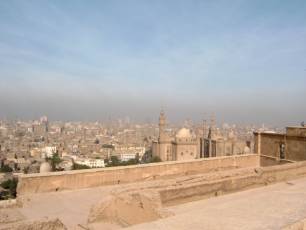 Our
first destination was the Citadel. It is the
city's fortress that once housed the royal family and although most
of the complex is open to visitors, the military still have a foothold
and some areas are out of bounds. It takes a half day to explore all
areas of the Citadel but we didn't have the opportunity to do so, and
instead spent most of our time in the Muhammad
Ali Mosque. Our
first destination was the Citadel. It is the
city's fortress that once housed the royal family and although most
of the complex is open to visitors, the military still have a foothold
and some areas are out of bounds. It takes a half day to explore all
areas of the Citadel but we didn't have the opportunity to do so, and
instead spent most of our time in the Muhammad
Ali Mosque.<== There is a magnificent view of the city from the Western Terraces - magnificent had most of Cairo not been filled with the same shade of mud-bricked buildings. What was most notable about Cairo was its lack of colour or rather its ability to blend into the desert. 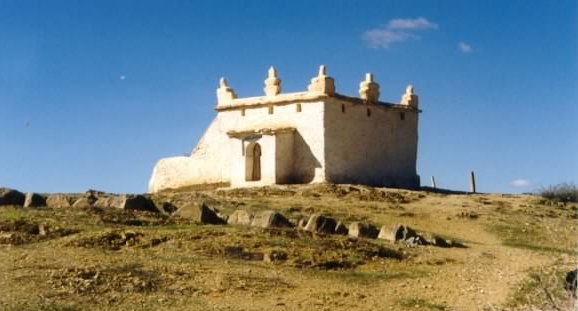 Our
guide Adam/Mohammed provided little insight to the function or history
of the Citadel, and instead sat the group in one corner of the Muhammad
Ali Mosque like a bunch of school children, and gave a lecture on Islamic
laws and behaviour. Our
guide Adam/Mohammed provided little insight to the function or history
of the Citadel, and instead sat the group in one corner of the Muhammad
Ali Mosque like a bunch of school children, and gave a lecture on Islamic
laws and behaviour.When René ventured to ask more about the Citadel, he was scolded for interrupting and told to listen. We never got the opportunity to find the number 7 Napoleon's troops had painted above one doorway to avoid using the unfamiliar Arabic names or the twin half-round towers because our guide simply didn't know where they were.  During this time, I had the opportunity to wander off and walk the beautiful alabaster-lined arcades of the mosque. the soaring central prayer hall was a glimmer of hundreds of lights hanging in concentric circles. Arabic inscriptions in gold were painted on the ceiling. Women had to be suitably attired and could not wear sleeveless tops or short skirts or shorts. In one corner lay the sarcophagus of Muhammad Ali - the builder of the mosque and an albanian mercenary who was the founder of the dynasty that ruled till the revolution in 1952. Cairo Egyptian Museum I have memories of wandering around this museum, peering into smudged glass cases, staring into the shrivelled faces of some once well-known pharaoh like Ramses II and wondering if the ancient Egyptians were giants in their large coffins. 20 years later, it was almost impossible to push through the crowds of tourists - only useful because their guides provided more information than ours. With only two hours, there was no way that we could view the whole museum or see the royal mummies. The museum was celebrating its centenary and there was a special exhibition dedicated to TutAnkhAmun - the most famous archaeological find. With travel guide in hand, we oohed and ahhed over the gold treasures found in his tomb - a gold throne featuring the famous scene of TutAnkhAmun's queen anointing him, chests made out of ebony ivory, cheetah-skinned hunting shields, bows, arrows, alabaster canopic jars holding King Tut's mummified organs, gold sarcophagus - if Howard Carter had found such treasures for a little known boy-king, imagine what the tomb of a pharaoh like Ramses II would have been like? King Tut's inner coffin of solid gold and the famous mask of gold that everyone wants to see and is portrayed in many egyptian images. The museum has become another money-making expedition for the Egyptians with an exhorbitant price to view the royal mummies. We had to content ourselves with the animal mummies - cats, dogs, birds, goats, Nile perch (yes, fish as well!) and most amazing was a 7-metre crocodile mummy. The exhibitions were arranged by themes on the upper floor and chronological on the lower floor, going clockwise from the Old Kingdom, to the Middle and finally to the New and later kingdoms. There were rooms full of giant sarcophagi that would've weighed a tonne each, a room full of miniatures showing the egyptians' daily lives, a room full of ancient papyrus long faded and rooms full of bits and pieces from ruins, statues, palace floors - a place where one needs a days to spend with a decent travel guide. |
Khan Al-Khalili 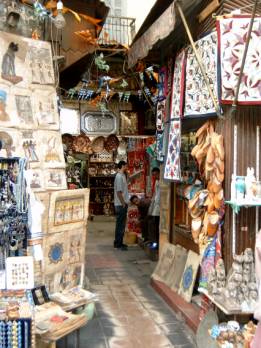 After
a stop at an egyptian perfumery and some lunch,
we headed to Khan Al-Khalili - the oldest
bazaar in Egypt that has lasted since the 1300s. Ancient buyers visited
the khan for goods brought in on merchant caravans. No longer do we
find slaves, silk, jewels or diamonds, but wooden guitars, brightly
patched pouffe covers, clothes, t-shirts, crappy papyrus paintings,
bongs/water pipes, bright bolts of cloth, the aroma of spices is very
much present and stalls are heaped with bright red, gold and blue powders
and sacks of seeds pods. Coppersmiths hammer out platters, tureens,
coffeepots and enormous crescent-shaped tops for minarets. It is a ritual
of the bazaar to expect to bargain - locals or foreign visitors - usually
a 10th of the offer price - if you have paid a third, you have paid
too much. We had only an hour to spare but many of the shops were closed
for a siesta after lunch. Ulla I pointed to bags of multicoloured
spices. He wanted £50 (AUD$10, 50DK.Kr) and after I said "da
ketir awi" (it costs too much) and walked away, the shopkeeper
doggedly followed us for a kilometre reducing the price from £40
to £30, £25, £20 and after we shouted £10 in
jest, he offered £15, £10 and finally £5 before finally
giving up on us. After much haggling, we managed to bargain for two
ornate glass perfume bottles for £20 (AUD$2.50; 20DK.Kr) After
a stop at an egyptian perfumery and some lunch,
we headed to Khan Al-Khalili - the oldest
bazaar in Egypt that has lasted since the 1300s. Ancient buyers visited
the khan for goods brought in on merchant caravans. No longer do we
find slaves, silk, jewels or diamonds, but wooden guitars, brightly
patched pouffe covers, clothes, t-shirts, crappy papyrus paintings,
bongs/water pipes, bright bolts of cloth, the aroma of spices is very
much present and stalls are heaped with bright red, gold and blue powders
and sacks of seeds pods. Coppersmiths hammer out platters, tureens,
coffeepots and enormous crescent-shaped tops for minarets. It is a ritual
of the bazaar to expect to bargain - locals or foreign visitors - usually
a 10th of the offer price - if you have paid a third, you have paid
too much. We had only an hour to spare but many of the shops were closed
for a siesta after lunch. Ulla I pointed to bags of multicoloured
spices. He wanted £50 (AUD$10, 50DK.Kr) and after I said "da
ketir awi" (it costs too much) and walked away, the shopkeeper
doggedly followed us for a kilometre reducing the price from £40
to £30, £25, £20 and after we shouted £10 in
jest, he offered £15, £10 and finally £5 before finally
giving up on us. After much haggling, we managed to bargain for two
ornate glass perfume bottles for £20 (AUD$2.50; 20DK.Kr) |
Bedstemor's Birthday Feast 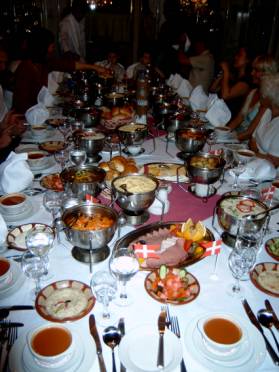 Irene
Ole had organised a private room for Bedstemor's
birthday party. A single long table in a room of egyptian style.
Small silver pots lined in two rows in the middle of the table kept
the food warm. Irene
Ole had organised a private room for Bedstemor's
birthday party. A single long table in a room of egyptian style.
Small silver pots lined in two rows in the middle of the table kept
the food warm.We feasted on cumin-flavoured fried fish, chicken fillets egyptian-style, cinammon-flavoured ravioli, rice, mashed potatoes and beef steaks in pepper sauce, sang and toasted with bottles of egyptian wine and beer to Bedstemor. Whilst the children played in one corner, there was much chatter througout the table and the evening finished off with chocolate and fruit cakes topped with "Happy Pirthday" (note, it's not an error) and we laughed in amusement in a plethora of egyptian sweets - baklawa, semolina tarts, rose-water flavoured tarts, and tarts that tasted like liquid honey... Ulla almost wanted to take the rest of the desserts with her (except for the rose-water flavoured ones - it was funny to watch her expression - rosewater almost smells like cosmetics). The waiters were extremely attentive, coming by every two minutes to serve us. Best of all, Bedstemor turned 2 years old, as she blew out each candle on the cakes. As the danes would say, "det var meget hyggeligt!" (it was cozy) |
Monday 15. november 2004 (7:30am start) From the brown buildings and streets of Cairo, we travelled 24km southeast of the city to Saqqara, changing from a uniform brown to lush green fields of large cabbages and hundreds of date palms. It was like an oasis, a gentle mist gave a surreal sense of the fertile plains of ancient Egypt. Women in full-length black abeeyas squatted in the fields, the odd man walking around - such a contrast to the intense crowds of central Cairo. Saqqara's Step Pyramid Founded as a necropolis (burial city) for the Old Kingdom and is one of the richest archaeological sites in Egypt. The Step Pyramid is less that ½ the height of the largest pyramids at Giza, but this monument served as a predecessor of the smooth pyramids. Previously tombs were made of mud brick, rectangular slablike structure covering a burial pit. But the architect Imhotep had the bright idea to construct in stone and  build
the slablike structure 5 times one on top of the other, creating the
first pyramid. build
the slablike structure 5 times one on top of the other, creating the
first pyramid.We entered through the Great South Court - the size of a soccer field, down a corridor of 40 pillars inspired by bundles of tied reeds. Whilst Adam was making another one of his speeches, I was tempted by a turbaned egyptian in a dress who took me to the top where I managed to get one shot of the magnificent pillars up top, before being scolded by Adam and being asked for baksheesh (tip). I was gratefully rescued by a couple of Italians when the egyptian would not let me go without a baksheesh. However, once I surfaced from the building, I was blinded by white sands and the immense pyramid sitting solitary amongst a few ruined stones, with a much smaller triangular heap of stones in the background. Although the morning had been cool, the sun soon warmed us up as we wandered round to the north. |
Memphis 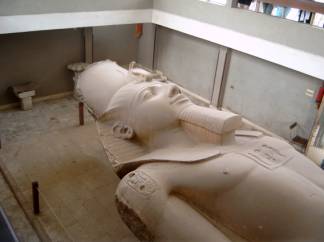 Once
the capital of ancient Egypt, it remains unexcavated
due to villages built on top of it and a high water table as a result
of the Aswan Dam. There is a small garden with small finds - bits and
pieces but the most exciting thing to see is a colossus of Ramses II
lying on his back as the lower legs are missing. The colossus would've
been 5 stories high had it been standing. Nearby lies the largest alabaster
statue ever found - 80 tons of sphinx - imagine what treasures that
could've been found if Memphis could've been excavated, especially as
this ancient city lay halfway between Upper and Lower Egypt. Once
the capital of ancient Egypt, it remains unexcavated
due to villages built on top of it and a high water table as a result
of the Aswan Dam. There is a small garden with small finds - bits and
pieces but the most exciting thing to see is a colossus of Ramses II
lying on his back as the lower legs are missing. The colossus would've
been 5 stories high had it been standing. Nearby lies the largest alabaster
statue ever found - 80 tons of sphinx - imagine what treasures that
could've been found if Memphis could've been excavated, especially as
this ancient city lay halfway between Upper and Lower Egypt.Our final stop before lunch was a papyrus museum - another place of commission for Adam. Bedstemor purchased a papyrus of egyptian alphabets. Some of the paintings cost a massive £3,500 (AUD$900, 3,500DK.Kr). For lunch, we had a splendid egyptian meal in the middle of nowhere that served excellent mezza (egyptian tapas) of baba ghanoush (roasted eggplant dip), tzatziki (cucumber dip), hummus (chickpea dip), fuul (beans) served with freshly made pita bread, warm vine-leaf rolls, lamb kofta and freshly roasted chicken in thyme. It was feast fit for a king and the most egyptian meal we had on the whole trip. |
 Pyramids
of Giza Pyramids
of GizaFrom air the desert pyramids were right on the edge of the city, 16km from Cairo. I remember vaguely, as a child, hunched over, walking up a surprisingly warm shaft lit by a single light bulbs and emerging into a very chilly dark room that held a single stone sarcophagus, the room empty except for occasional square holes in the wall where food was left for the afterlife. I had entered the Queen's chamber in the largest pyramid and 20 years later, only the first 300 can enter these pyramids - for an exhorbitant fee. |
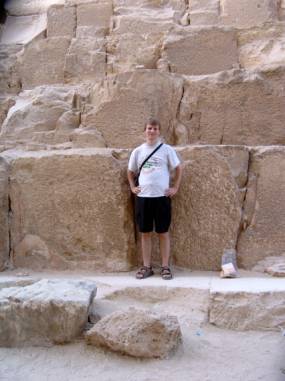 The largest of the three, Cheops' pyramid was the largest, standing at 146metres at one point, took 920 metres to walk around it and contained 2.3 million blocks! Each block was at least one metre high, so you can imagine how massive these pyramids were. 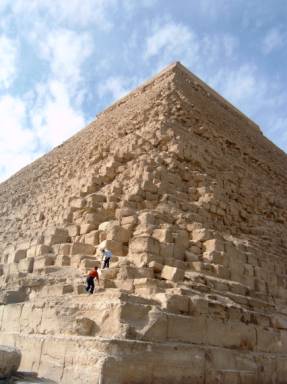 The 2nd largest, Khefren's (Cheop's son) pyramid still had some of the smooth shiny limestone casing that once used to cover all these pyramids.==> The massive solar boat that once carried the pharaoh's body from Memphis to Giza and the three smaller Queens' pyramids stood at one corner of the massive Cheop pyramid. We didn't have the opportunity this time to enter the tombs, but I feel priveleged that I did and that I still have some memories of the event. |
The Sphinx 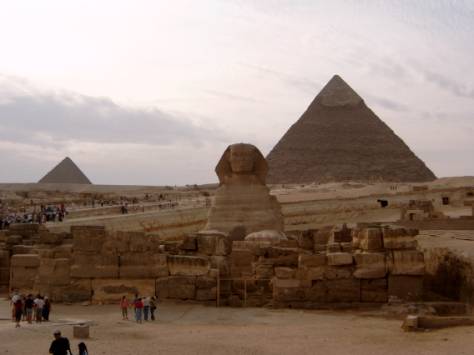 The
pyramids loomed in the background as it sat silently on the hot sand
under the glaring sunlight for 4,000 years. Napoleon's troops once used
it for target practice, so its nose and pharaohs beard and long fallen
off and lies in a British museum. The Greeks called it "the
Sphinx" as it was based on a mystical creature with the head
of a man and body of a lion, which would stop any traveller along the
way with a riddle - if the riddle wasn't answered, it became the sphinx's
dinner. Throngs of crowds surrounded the sphinx and we could only enter
in single file. Over time, it seemed that tourists could view it from
further and further away. 45 years ago, Bedstefar's (grandfather) could
touch the Sphinx and even climb to the top of the pyramid; 20 years
ago, it was simply surrounded by a small wire fence but I could stand
close up to it; now it lay in a very large pit where visitors could
only view it up close if they zoomed in on their cameras. 4 millenia
later, it still manages to awe all of us. The
pyramids loomed in the background as it sat silently on the hot sand
under the glaring sunlight for 4,000 years. Napoleon's troops once used
it for target practice, so its nose and pharaohs beard and long fallen
off and lies in a British museum. The Greeks called it "the
Sphinx" as it was based on a mystical creature with the head
of a man and body of a lion, which would stop any traveller along the
way with a riddle - if the riddle wasn't answered, it became the sphinx's
dinner. Throngs of crowds surrounded the sphinx and we could only enter
in single file. Over time, it seemed that tourists could view it from
further and further away. 45 years ago, Bedstefar's (grandfather) could
touch the Sphinx and even climb to the top of the pyramid; 20 years
ago, it was simply surrounded by a small wire fence but I could stand
close up to it; now it lay in a very large pit where visitors could
only view it up close if they zoomed in on their cameras. 4 millenia
later, it still manages to awe all of us. |
Tuesday 16. november 2004 (2:30am start) Yes, you did read that right - we were all waiting in the lobby at 2:30AM. Last night, Bedstemor's grandchildren treated the family to a Spanish-Egyptian Italian dinner, which was followed by a 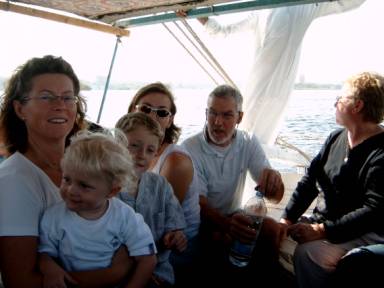 cacophany
of tambourines, oboes and drums played for an Egyptian engagement couple
in the lobby. cacophany
of tambourines, oboes and drums played for an Egyptian engagement couple
in the lobby.This morning we were flying to Aswan, to board a 3-day cruise up the Nile, sailing up to Luxor. When we arrived, we were taken for a short felucca ride along the Nile with a fantastic view of the Tomb of Nobles. When we returned we were given our rooms onboard a four-storey cruise ship that had an indoor games room, a pool and sundeck at the top. Even from our rooms right at the bottom, we had a magnificent view of a small white mosque-like structure on top of huge sandy mountains dotted with small caves. In the evening we had the opportunity to visit a small souq (local bazaar) selling t-shirts, papyrus paintings, mounds of saffron and dry scented lotus flowers, brown, red, yellow indigo mounds of fragrant spices - all of which some of us bargained for - the most expensive £25 papyrus painting (AUD$5, 25DK.Kr) to cheapest £15 embroidered t-shirts with hieroglyphics (AUD$3, 15DK.Kr). To top the evening off, we took a £5 horse carriage ride back to the ship. |
Wednesday 17. november 2004 (7:30am start) It seemed some of the family had succumbed to a tummy bug. The rest of us steered clear of unwashed fruit, fresh salads, raw vegetables and drinks made with local water. However, this didn't stop us from going out to see a few sights. The Unfinished Obelisk Had this obelisk been completed, it would've been the largest and heaviest ever made standing at 142 metres. It sat in a granite quarry, perfectly complete on three sides but abandoned when a flaw was found in the stone. It is almost impossible to imagine how the ancient egyptians could've moved even a single rock made from this quarry as it stood a great many miles from any of the monuments ever made. Unfortunately for Egypt, most of its obelisks have been spirited to other countries - to Italy, Britain, France and even Argentina by foreign archaeologists in the last centuries. Most of us didn't have the chance to view the complete obelisk before Adam rang a bell that he carried (to annoy us I suppose) |
|
High Dam  For
centuries the Nile controlled the Egyptians' lives - either flooding
or insufficient water levels were disastrous for the people who relied
on this huge water source for their livelihood. When the Aswan
Dam was built, some of the villages in the south lost their water
supply. For
centuries the Nile controlled the Egyptians' lives - either flooding
or insufficient water levels were disastrous for the people who relied
on this huge water source for their livelihood. When the Aswan
Dam was built, some of the villages in the south lost their water
supply.30 years ago, a new High Dam was built which resulted in the man-made Lake Nasser to the south being created ==> This meant many people had to be moved as villages were buried, as well as some of the ancient egyptian monuments such as the Temple of Philae. |
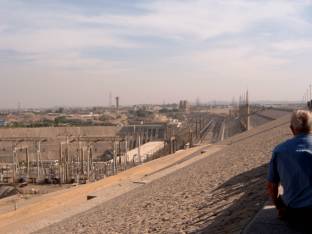 At
its highest point, the High Dam stands at 111m high, 3.8km long and
980m wide at the base. At
its highest point, the High Dam stands at 111m high, 3.8km long and
980m wide at the base.Three times the number of stones used for Cheops' Pyramid was used. Videoing isn't allowed as it is a high-security military area - should there be an attack on this Dam, then much of Egypt would be submerged under water and would be a disaster for the country. Given only 10min, Adam "rang" us back to the bus. |
Temple of Philae 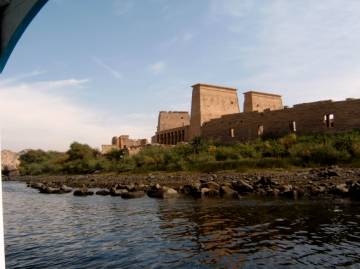 After
Aswan Dam, the Temple of Philae was submerged
for six months a year and tourists had to view it through the murky
waters of Lake Philae. When the High Dam was built, it threatened to
submerge the Temple permanently, so was moved stone by stone to a new
island similarly landscaped. Philae is special in that it's only accessible
by boat and the sunset forms a spectactular backdrop. A temple dedicated
to Isis (goddess of women, sex purity), it was one of the last
outposes for paganism and due to the popularity of Isis, was also used
by the early Christians. The Temple walls and many pillars were filled
from top to bottom with hieroglyphs and images of Isis - many defaced
by the early Christians who considered ancient Egypt's gods to be "pagan".
I had a fantastic afternoon walking in and out of all the nook and crannies
- visiting the Birth House, Nilometer, the "Pharaoh's Bedstead"
and much to the amusement of the family, I was the last to emerge. After
Aswan Dam, the Temple of Philae was submerged
for six months a year and tourists had to view it through the murky
waters of Lake Philae. When the High Dam was built, it threatened to
submerge the Temple permanently, so was moved stone by stone to a new
island similarly landscaped. Philae is special in that it's only accessible
by boat and the sunset forms a spectactular backdrop. A temple dedicated
to Isis (goddess of women, sex purity), it was one of the last
outposes for paganism and due to the popularity of Isis, was also used
by the early Christians. The Temple walls and many pillars were filled
from top to bottom with hieroglyphs and images of Isis - many defaced
by the early Christians who considered ancient Egypt's gods to be "pagan".
I had a fantastic afternoon walking in and out of all the nook and crannies
- visiting the Birth House, Nilometer, the "Pharaoh's Bedstead"
and much to the amusement of the family, I was the last to emerge. |
 Kom
Ombo Kom
OmboThe ship set sail from Aswan at 3:45pm after an afternoon spent sunbaking and drinking beer (typically danish to make the most of sunshine and beer). We were sailing 48km north of Aswan to Kom Ombo - the site of an ancient city devoted to the worship of a crocodile god, Sobek. The ancient city is long gone and crocodiles existing on nearby sandbanks have been hunted to extinction. At sunset, we visited the Temple of Kom Ombo, dedicated to both Sobek the Crocodile god and Horus, the falcon-headed sky god Isis' son. Although we didn't have the opportunity to explore this 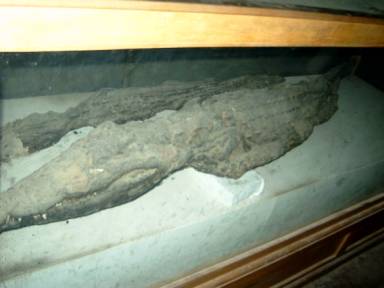 temple,
it was both spectacular and eerie at sunset, with large light illuminating
it. There existed a pit filled with water, with a platform halfway down,
where crocodiles were lured in from the Nile with human flesh, and the
largest crocodile was caught and mummified as a tribute to Sobek. At
the Chapel of Hathor (Horus' wife), an American shouted "Geez,
I thought I was supposed to see crocodile statues!" *laugh* It
contained two of the mummified crocodiles found at the Temple. temple,
it was both spectacular and eerie at sunset, with large light illuminating
it. There existed a pit filled with water, with a platform halfway down,
where crocodiles were lured in from the Nile with human flesh, and the
largest crocodile was caught and mummified as a tribute to Sobek. At
the Chapel of Hathor (Horus' wife), an American shouted "Geez,
I thought I was supposed to see crocodile statues!" *laugh* It
contained two of the mummified crocodiles found at the Temple.We returned to a small cocktail party before dinner, provided by the ship to introduce all the staff responsible for making our trip enjoyable. |
Thursday 18. november 2004 (7am start) We sailed overnight past Kom Ombo to Edfu, a small regional center for the sugarcane trade, visited the Temple of Horus and sailed on to the Lock-crossing at Esna. Temple of Horus 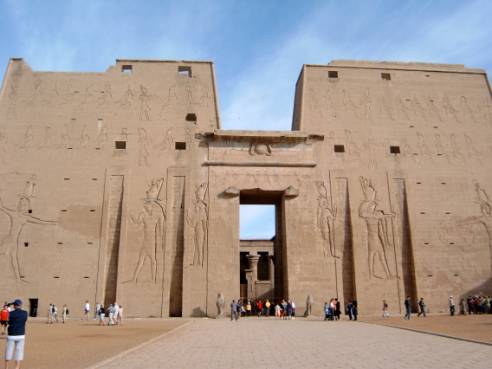 This
is the most complete of its kind, a Greco-Roman
temple that conforms exactly to ancient egyptian principles of architecture
ie visit Edfu to see what almost every other temple in Egypt would've
looked like in its original form. We were awed by the massive walls
of the pylons at the entrance, distince reliefs showing mirror images
of Horus and the pharaoh grasping the hair of his enemies. It was built
by Cleopatra's father around 50yr BC. Standing in the forecourt of this
well-preserved temple we can see mud-brick houses lined up at the top
of the compound walls because this temple was once buried right up to
the ceiling with a village built on top of it. Many of the temple relifes
capture the cataclysmic battle of Horus with his brother Seth. We entered
a small Nilometer - a dark, dank tunnel that smelled of pee and was
once used to measure the level of the Nile. Again I was the last to
emerge (a couple of minutes late only) to the loud applause of everyone
(and a huge glare from Adam). This
is the most complete of its kind, a Greco-Roman
temple that conforms exactly to ancient egyptian principles of architecture
ie visit Edfu to see what almost every other temple in Egypt would've
looked like in its original form. We were awed by the massive walls
of the pylons at the entrance, distince reliefs showing mirror images
of Horus and the pharaoh grasping the hair of his enemies. It was built
by Cleopatra's father around 50yr BC. Standing in the forecourt of this
well-preserved temple we can see mud-brick houses lined up at the top
of the compound walls because this temple was once buried right up to
the ceiling with a village built on top of it. Many of the temple relifes
capture the cataclysmic battle of Horus with his brother Seth. We entered
a small Nilometer - a dark, dank tunnel that smelled of pee and was
once used to measure the level of the Nile. Again I was the last to
emerge (a couple of minutes late only) to the loud applause of everyone
(and a huge glare from Adam). |
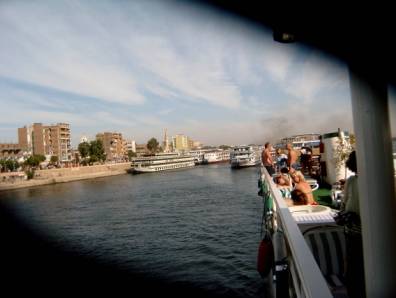 Returning
to the ship in time for the 9am sail, we set off for Esna, 48km south
of Luxor. Whilst the family tanned on the sundeck,
I sat in the sun at the front of the boat, enjoying sense of peace and
tranquility. It was truly beautiful to sit on a boat not too big or
small, to watch the changing scenery on both sides, passed fields of
giant palms and lush green fields, a smoking metal, the ship moving
at a leisurely 16km/hr and passing some incredibe mounta Returning
to the ship in time for the 9am sail, we set off for Esna, 48km south
of Luxor. Whilst the family tanned on the sundeck,
I sat in the sun at the front of the boat, enjoying sense of peace and
tranquility. It was truly beautiful to sit on a boat not too big or
small, to watch the changing scenery on both sides, passed fields of
giant palms and lush green fields, a smoking metal, the ship moving
at a leisurely 16km/hr and passing some incredibe mounta
|





